Organizational Changes in Walmart: Analysis, Impact, and Strategies
VerifiedAdded on 2020/03/16
|12
|2792
|63
Report
AI Summary
This report examines the organizational changes undertaken by Walmart, a major player in the retail sector. It explores both internal and external factors driving these changes, such as globalization, technology, and evolving customer preferences, which are leading to a greater emphasis on e-commerce and a reduction in physical store presence. The report analyzes the impact of these changes on Walmart's business, including increased competitive advantage. It also delves into the change process, identifying key factors like customer preferences, globalization, competition, and streamlined decision-making. Furthermore, the report compares and contrasts three change management approaches—Lewin's, McKinsey's 7S, and ADKAR models—and discusses different employee behavioral responses to change. Finally, it suggests ways in which HR could have supported employees during this organizational transition, offering insights into effective change management strategies within a large retail organization.
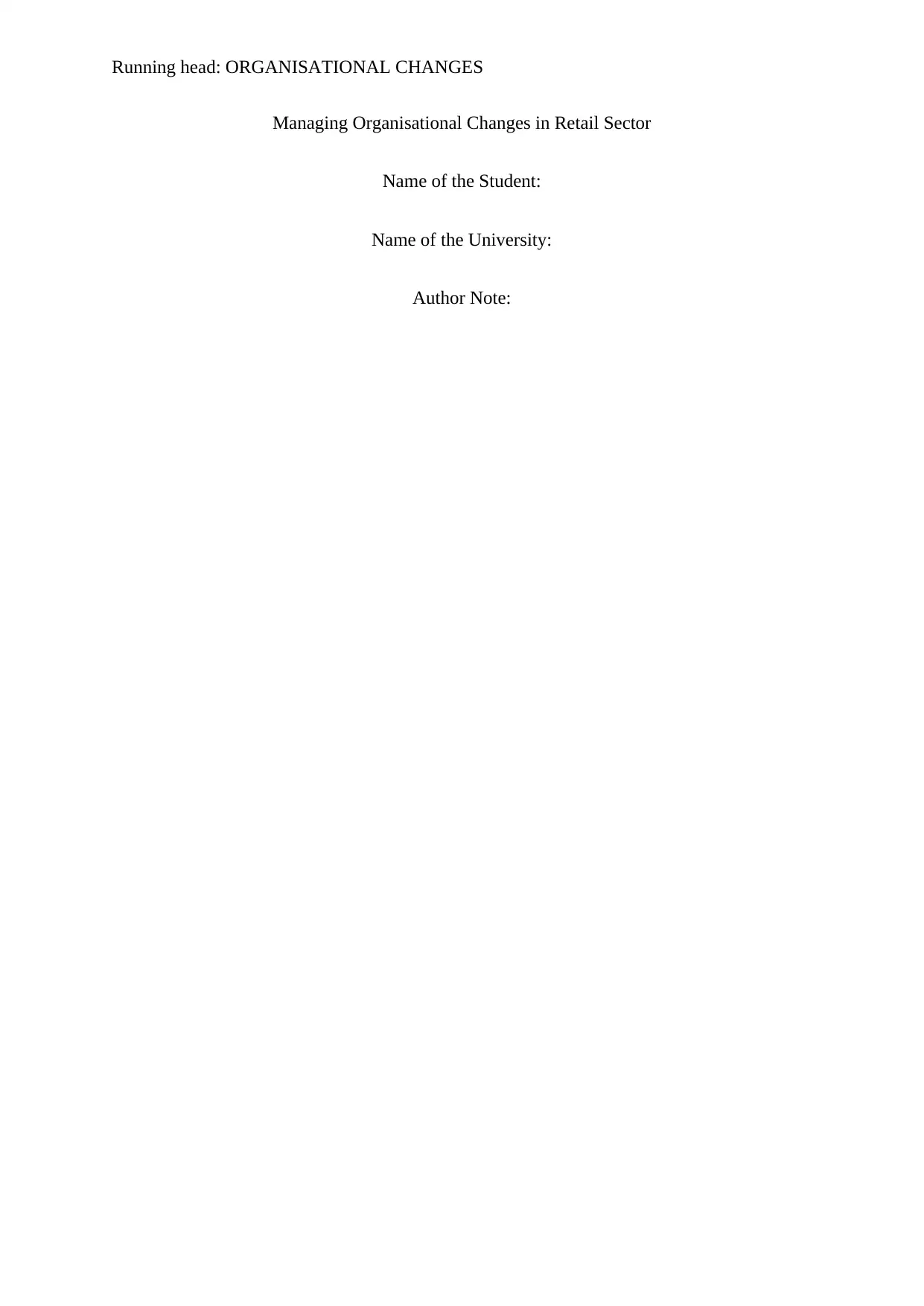
Running head: ORGANISATIONAL CHANGES
Managing Organisational Changes in Retail Sector
Name of the Student:
Name of the University:
Author Note:
Managing Organisational Changes in Retail Sector
Name of the Student:
Name of the University:
Author Note:
Paraphrase This Document
Need a fresh take? Get an instant paraphrase of this document with our AI Paraphraser
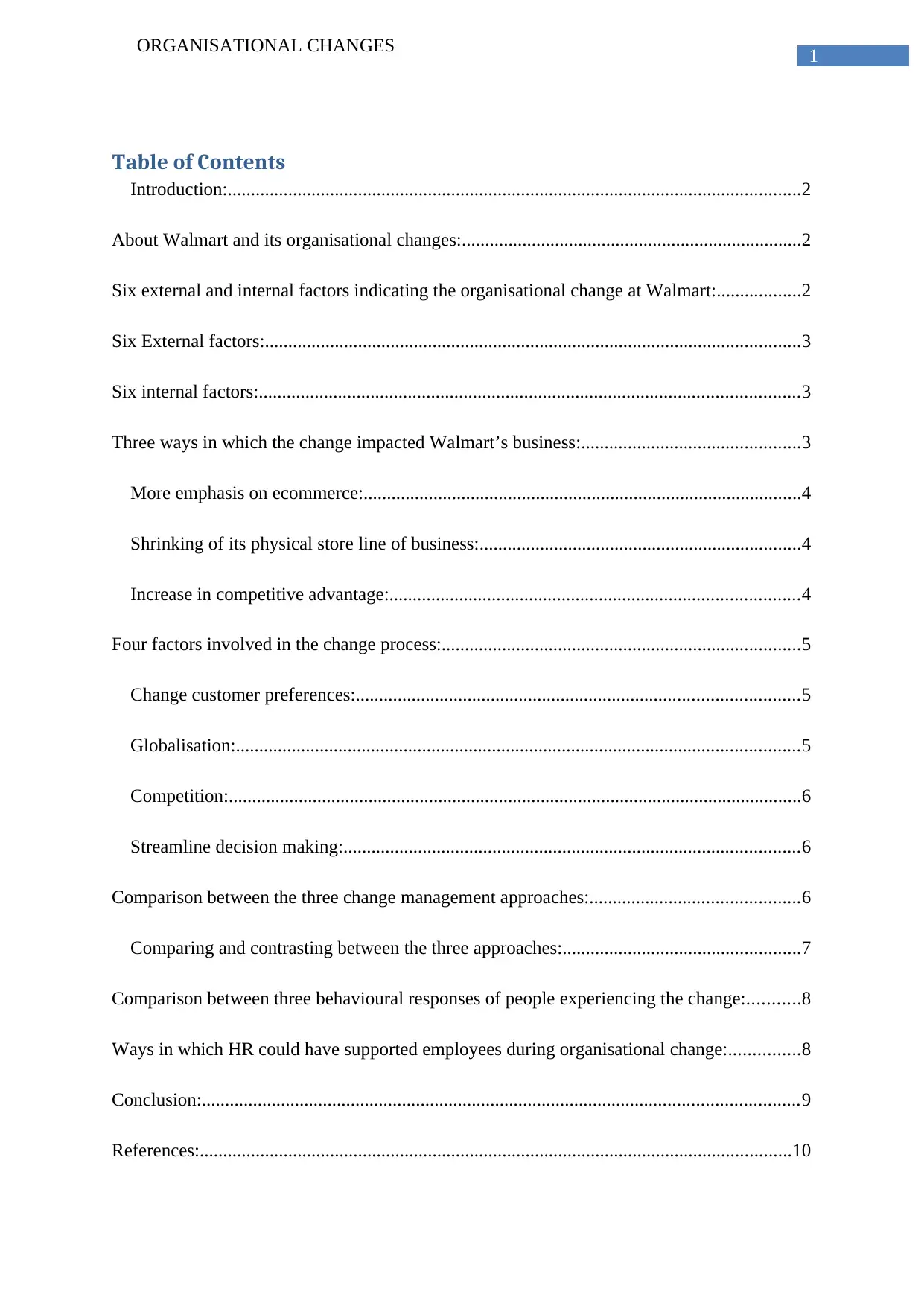
1
ORGANISATIONAL CHANGES
Table of Contents
Introduction:...........................................................................................................................2
About Walmart and its organisational changes:.........................................................................2
Six external and internal factors indicating the organisational change at Walmart:..................2
Six External factors:...................................................................................................................3
Six internal factors:....................................................................................................................3
Three ways in which the change impacted Walmart’s business:...............................................3
More emphasis on ecommerce:..............................................................................................4
Shrinking of its physical store line of business:.....................................................................4
Increase in competitive advantage:........................................................................................4
Four factors involved in the change process:.............................................................................5
Change customer preferences:...............................................................................................5
Globalisation:.........................................................................................................................5
Competition:...........................................................................................................................6
Streamline decision making:..................................................................................................6
Comparison between the three change management approaches:.............................................6
Comparing and contrasting between the three approaches:...................................................7
Comparison between three behavioural responses of people experiencing the change:...........8
Ways in which HR could have supported employees during organisational change:...............8
Conclusion:................................................................................................................................9
References:...............................................................................................................................10
ORGANISATIONAL CHANGES
Table of Contents
Introduction:...........................................................................................................................2
About Walmart and its organisational changes:.........................................................................2
Six external and internal factors indicating the organisational change at Walmart:..................2
Six External factors:...................................................................................................................3
Six internal factors:....................................................................................................................3
Three ways in which the change impacted Walmart’s business:...............................................3
More emphasis on ecommerce:..............................................................................................4
Shrinking of its physical store line of business:.....................................................................4
Increase in competitive advantage:........................................................................................4
Four factors involved in the change process:.............................................................................5
Change customer preferences:...............................................................................................5
Globalisation:.........................................................................................................................5
Competition:...........................................................................................................................6
Streamline decision making:..................................................................................................6
Comparison between the three change management approaches:.............................................6
Comparing and contrasting between the three approaches:...................................................7
Comparison between three behavioural responses of people experiencing the change:...........8
Ways in which HR could have supported employees during organisational change:...............8
Conclusion:................................................................................................................................9
References:...............................................................................................................................10
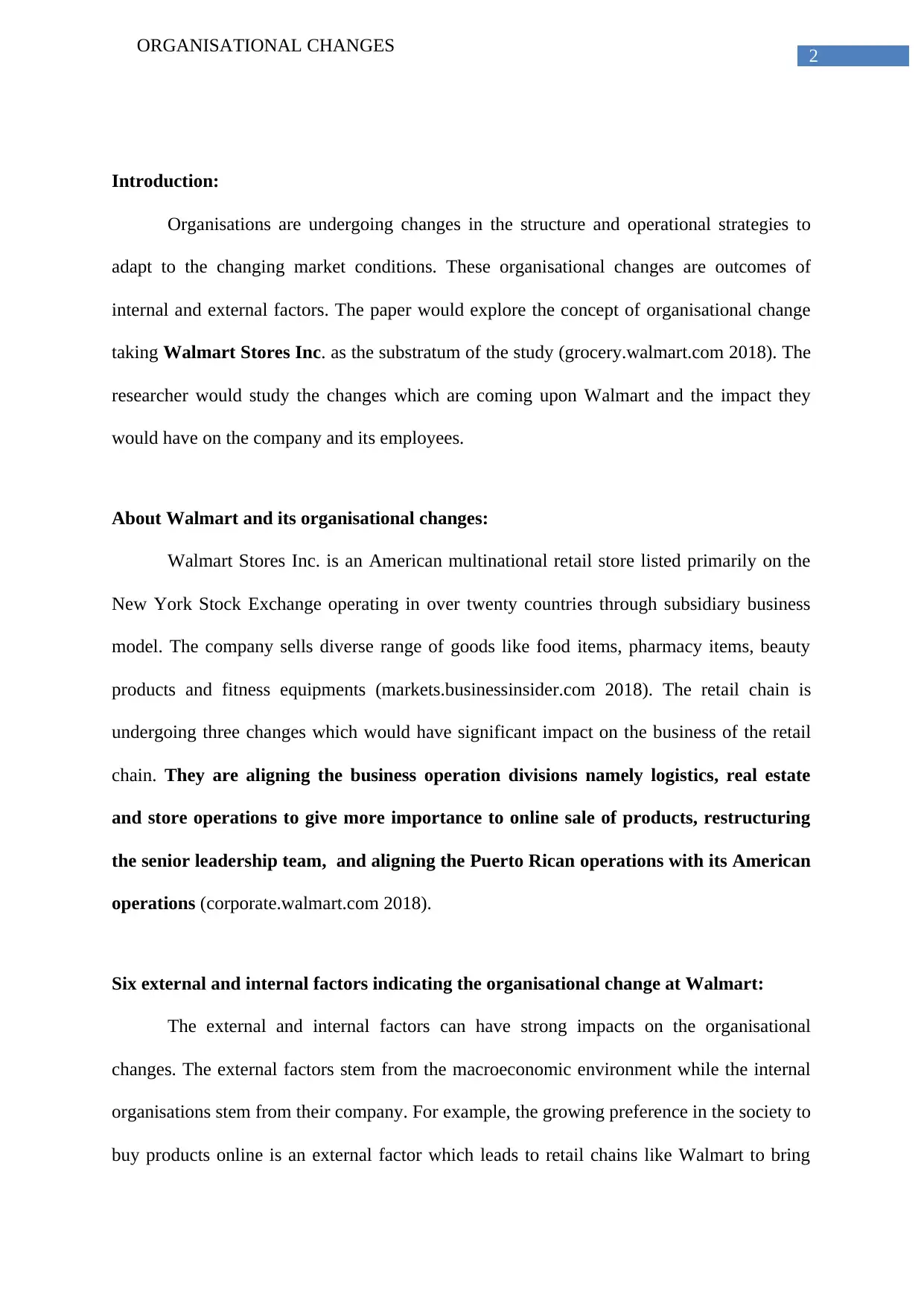
2
ORGANISATIONAL CHANGES
Introduction:
Organisations are undergoing changes in the structure and operational strategies to
adapt to the changing market conditions. These organisational changes are outcomes of
internal and external factors. The paper would explore the concept of organisational change
taking Walmart Stores Inc. as the substratum of the study (grocery.walmart.com 2018). The
researcher would study the changes which are coming upon Walmart and the impact they
would have on the company and its employees.
About Walmart and its organisational changes:
Walmart Stores Inc. is an American multinational retail store listed primarily on the
New York Stock Exchange operating in over twenty countries through subsidiary business
model. The company sells diverse range of goods like food items, pharmacy items, beauty
products and fitness equipments (markets.businessinsider.com 2018). The retail chain is
undergoing three changes which would have significant impact on the business of the retail
chain. They are aligning the business operation divisions namely logistics, real estate
and store operations to give more importance to online sale of products, restructuring
the senior leadership team, and aligning the Puerto Rican operations with its American
operations (corporate.walmart.com 2018).
Six external and internal factors indicating the organisational change at Walmart:
The external and internal factors can have strong impacts on the organisational
changes. The external factors stem from the macroeconomic environment while the internal
organisations stem from their company. For example, the growing preference in the society to
buy products online is an external factor which leads to retail chains like Walmart to bring
ORGANISATIONAL CHANGES
Introduction:
Organisations are undergoing changes in the structure and operational strategies to
adapt to the changing market conditions. These organisational changes are outcomes of
internal and external factors. The paper would explore the concept of organisational change
taking Walmart Stores Inc. as the substratum of the study (grocery.walmart.com 2018). The
researcher would study the changes which are coming upon Walmart and the impact they
would have on the company and its employees.
About Walmart and its organisational changes:
Walmart Stores Inc. is an American multinational retail store listed primarily on the
New York Stock Exchange operating in over twenty countries through subsidiary business
model. The company sells diverse range of goods like food items, pharmacy items, beauty
products and fitness equipments (markets.businessinsider.com 2018). The retail chain is
undergoing three changes which would have significant impact on the business of the retail
chain. They are aligning the business operation divisions namely logistics, real estate
and store operations to give more importance to online sale of products, restructuring
the senior leadership team, and aligning the Puerto Rican operations with its American
operations (corporate.walmart.com 2018).
Six external and internal factors indicating the organisational change at Walmart:
The external and internal factors can have strong impacts on the organisational
changes. The external factors stem from the macroeconomic environment while the internal
organisations stem from their company. For example, the growing preference in the society to
buy products online is an external factor which leads to retail chains like Walmart to bring
⊘ This is a preview!⊘
Do you want full access?
Subscribe today to unlock all pages.

Trusted by 1+ million students worldwide
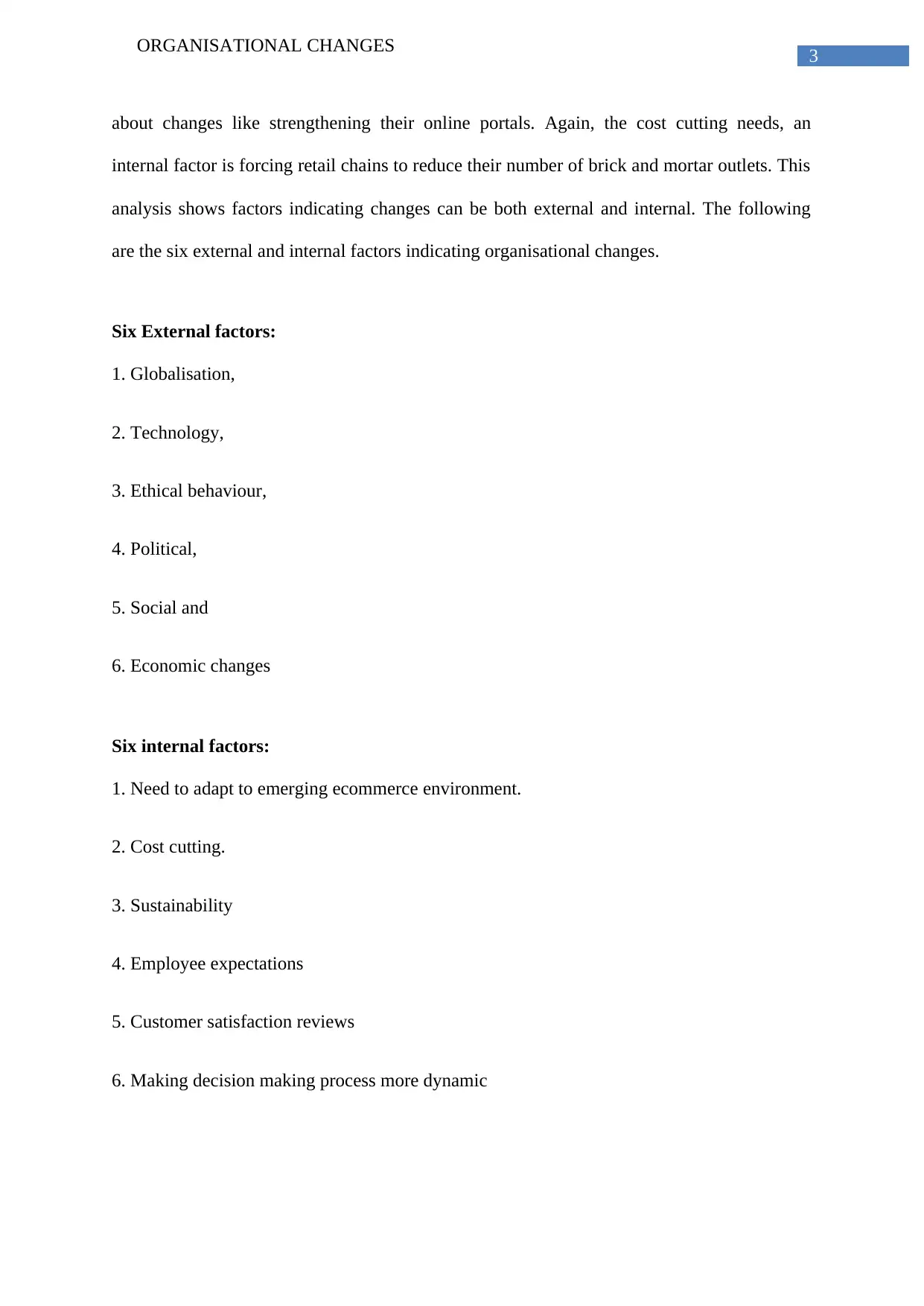
3
ORGANISATIONAL CHANGES
about changes like strengthening their online portals. Again, the cost cutting needs, an
internal factor is forcing retail chains to reduce their number of brick and mortar outlets. This
analysis shows factors indicating changes can be both external and internal. The following
are the six external and internal factors indicating organisational changes.
Six External factors:
1. Globalisation,
2. Technology,
3. Ethical behaviour,
4. Political,
5. Social and
6. Economic changes
Six internal factors:
1. Need to adapt to emerging ecommerce environment.
2. Cost cutting.
3. Sustainability
4. Employee expectations
5. Customer satisfaction reviews
6. Making decision making process more dynamic
ORGANISATIONAL CHANGES
about changes like strengthening their online portals. Again, the cost cutting needs, an
internal factor is forcing retail chains to reduce their number of brick and mortar outlets. This
analysis shows factors indicating changes can be both external and internal. The following
are the six external and internal factors indicating organisational changes.
Six External factors:
1. Globalisation,
2. Technology,
3. Ethical behaviour,
4. Political,
5. Social and
6. Economic changes
Six internal factors:
1. Need to adapt to emerging ecommerce environment.
2. Cost cutting.
3. Sustainability
4. Employee expectations
5. Customer satisfaction reviews
6. Making decision making process more dynamic
Paraphrase This Document
Need a fresh take? Get an instant paraphrase of this document with our AI Paraphraser
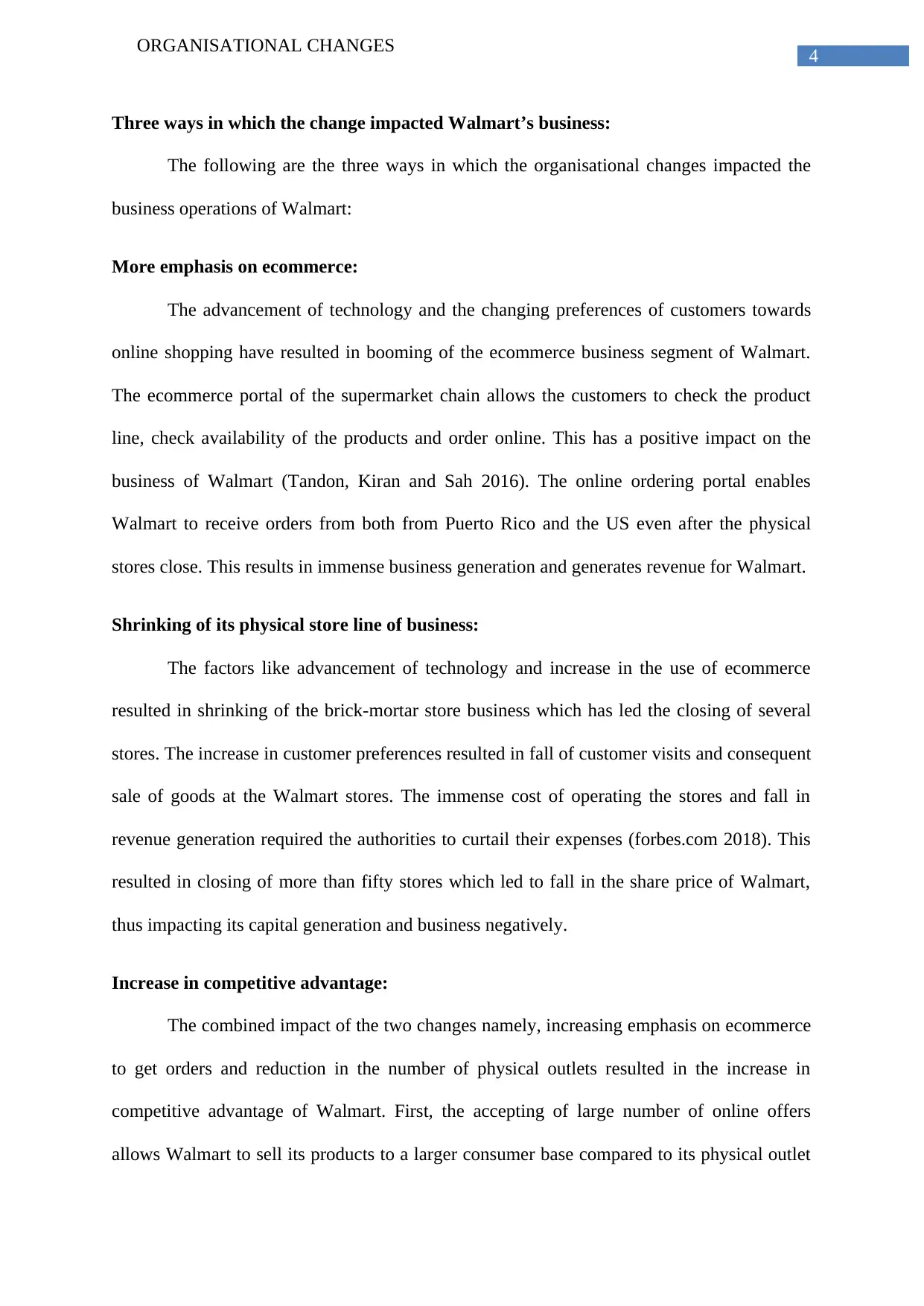
4
ORGANISATIONAL CHANGES
Three ways in which the change impacted Walmart’s business:
The following are the three ways in which the organisational changes impacted the
business operations of Walmart:
More emphasis on ecommerce:
The advancement of technology and the changing preferences of customers towards
online shopping have resulted in booming of the ecommerce business segment of Walmart.
The ecommerce portal of the supermarket chain allows the customers to check the product
line, check availability of the products and order online. This has a positive impact on the
business of Walmart (Tandon, Kiran and Sah 2016). The online ordering portal enables
Walmart to receive orders from both from Puerto Rico and the US even after the physical
stores close. This results in immense business generation and generates revenue for Walmart.
Shrinking of its physical store line of business:
The factors like advancement of technology and increase in the use of ecommerce
resulted in shrinking of the brick-mortar store business which has led the closing of several
stores. The increase in customer preferences resulted in fall of customer visits and consequent
sale of goods at the Walmart stores. The immense cost of operating the stores and fall in
revenue generation required the authorities to curtail their expenses (forbes.com 2018). This
resulted in closing of more than fifty stores which led to fall in the share price of Walmart,
thus impacting its capital generation and business negatively.
Increase in competitive advantage:
The combined impact of the two changes namely, increasing emphasis on ecommerce
to get orders and reduction in the number of physical outlets resulted in the increase in
competitive advantage of Walmart. First, the accepting of large number of online offers
allows Walmart to sell its products to a larger consumer base compared to its physical outlet
ORGANISATIONAL CHANGES
Three ways in which the change impacted Walmart’s business:
The following are the three ways in which the organisational changes impacted the
business operations of Walmart:
More emphasis on ecommerce:
The advancement of technology and the changing preferences of customers towards
online shopping have resulted in booming of the ecommerce business segment of Walmart.
The ecommerce portal of the supermarket chain allows the customers to check the product
line, check availability of the products and order online. This has a positive impact on the
business of Walmart (Tandon, Kiran and Sah 2016). The online ordering portal enables
Walmart to receive orders from both from Puerto Rico and the US even after the physical
stores close. This results in immense business generation and generates revenue for Walmart.
Shrinking of its physical store line of business:
The factors like advancement of technology and increase in the use of ecommerce
resulted in shrinking of the brick-mortar store business which has led the closing of several
stores. The increase in customer preferences resulted in fall of customer visits and consequent
sale of goods at the Walmart stores. The immense cost of operating the stores and fall in
revenue generation required the authorities to curtail their expenses (forbes.com 2018). This
resulted in closing of more than fifty stores which led to fall in the share price of Walmart,
thus impacting its capital generation and business negatively.
Increase in competitive advantage:
The combined impact of the two changes namely, increasing emphasis on ecommerce
to get orders and reduction in the number of physical outlets resulted in the increase in
competitive advantage of Walmart. First, the accepting of large number of online offers
allows Walmart to sell its products to a larger consumer base compared to its physical outlet
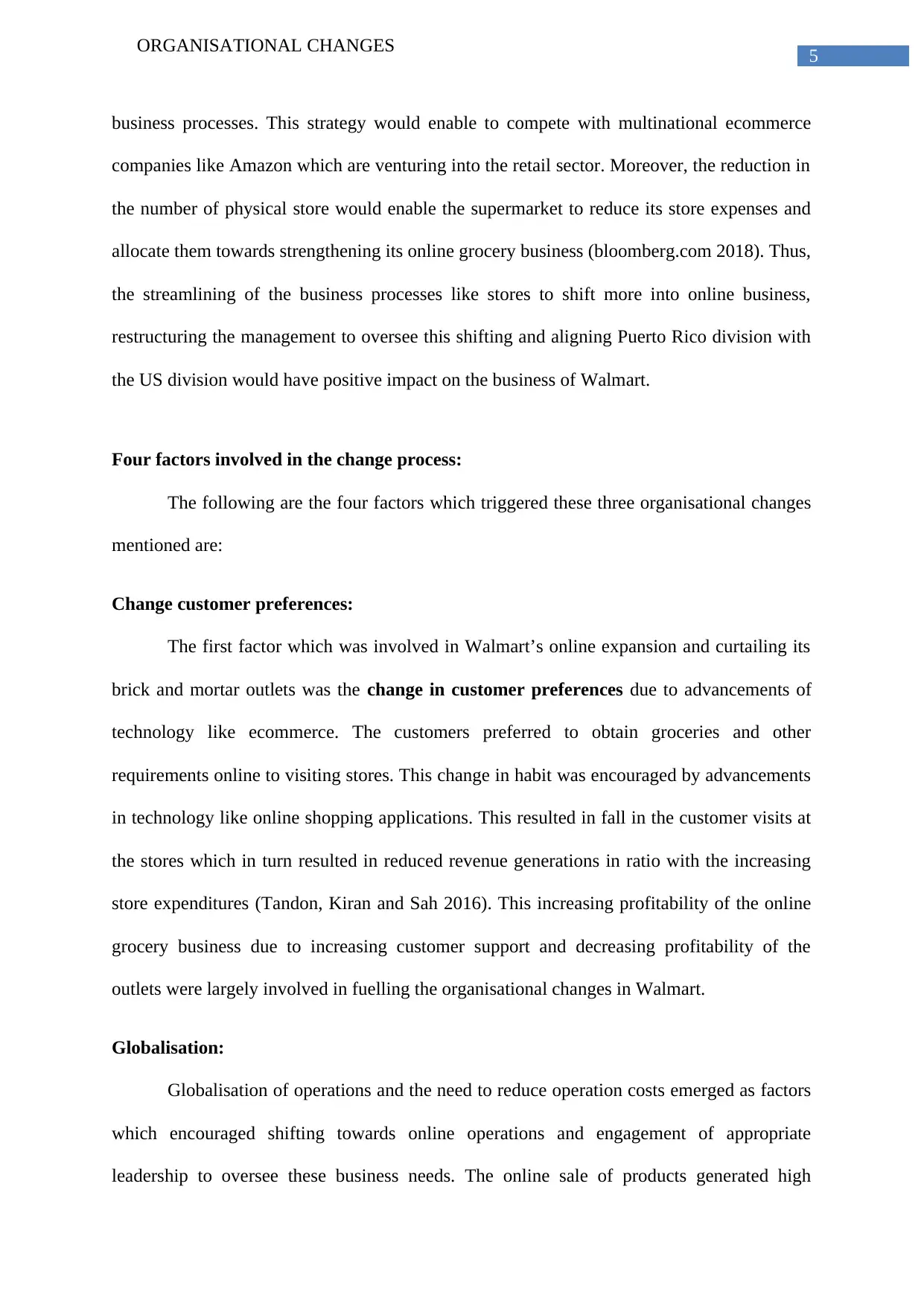
5
ORGANISATIONAL CHANGES
business processes. This strategy would enable to compete with multinational ecommerce
companies like Amazon which are venturing into the retail sector. Moreover, the reduction in
the number of physical store would enable the supermarket to reduce its store expenses and
allocate them towards strengthening its online grocery business (bloomberg.com 2018). Thus,
the streamlining of the business processes like stores to shift more into online business,
restructuring the management to oversee this shifting and aligning Puerto Rico division with
the US division would have positive impact on the business of Walmart.
Four factors involved in the change process:
The following are the four factors which triggered these three organisational changes
mentioned are:
Change customer preferences:
The first factor which was involved in Walmart’s online expansion and curtailing its
brick and mortar outlets was the change in customer preferences due to advancements of
technology like ecommerce. The customers preferred to obtain groceries and other
requirements online to visiting stores. This change in habit was encouraged by advancements
in technology like online shopping applications. This resulted in fall in the customer visits at
the stores which in turn resulted in reduced revenue generations in ratio with the increasing
store expenditures (Tandon, Kiran and Sah 2016). This increasing profitability of the online
grocery business due to increasing customer support and decreasing profitability of the
outlets were largely involved in fuelling the organisational changes in Walmart.
Globalisation:
Globalisation of operations and the need to reduce operation costs emerged as factors
which encouraged shifting towards online operations and engagement of appropriate
leadership to oversee these business needs. The online sale of products generated high
ORGANISATIONAL CHANGES
business processes. This strategy would enable to compete with multinational ecommerce
companies like Amazon which are venturing into the retail sector. Moreover, the reduction in
the number of physical store would enable the supermarket to reduce its store expenses and
allocate them towards strengthening its online grocery business (bloomberg.com 2018). Thus,
the streamlining of the business processes like stores to shift more into online business,
restructuring the management to oversee this shifting and aligning Puerto Rico division with
the US division would have positive impact on the business of Walmart.
Four factors involved in the change process:
The following are the four factors which triggered these three organisational changes
mentioned are:
Change customer preferences:
The first factor which was involved in Walmart’s online expansion and curtailing its
brick and mortar outlets was the change in customer preferences due to advancements of
technology like ecommerce. The customers preferred to obtain groceries and other
requirements online to visiting stores. This change in habit was encouraged by advancements
in technology like online shopping applications. This resulted in fall in the customer visits at
the stores which in turn resulted in reduced revenue generations in ratio with the increasing
store expenditures (Tandon, Kiran and Sah 2016). This increasing profitability of the online
grocery business due to increasing customer support and decreasing profitability of the
outlets were largely involved in fuelling the organisational changes in Walmart.
Globalisation:
Globalisation of operations and the need to reduce operation costs emerged as factors
which encouraged shifting towards online operations and engagement of appropriate
leadership to oversee these business needs. The online sale of products generated high
⊘ This is a preview!⊘
Do you want full access?
Subscribe today to unlock all pages.

Trusted by 1+ million students worldwide
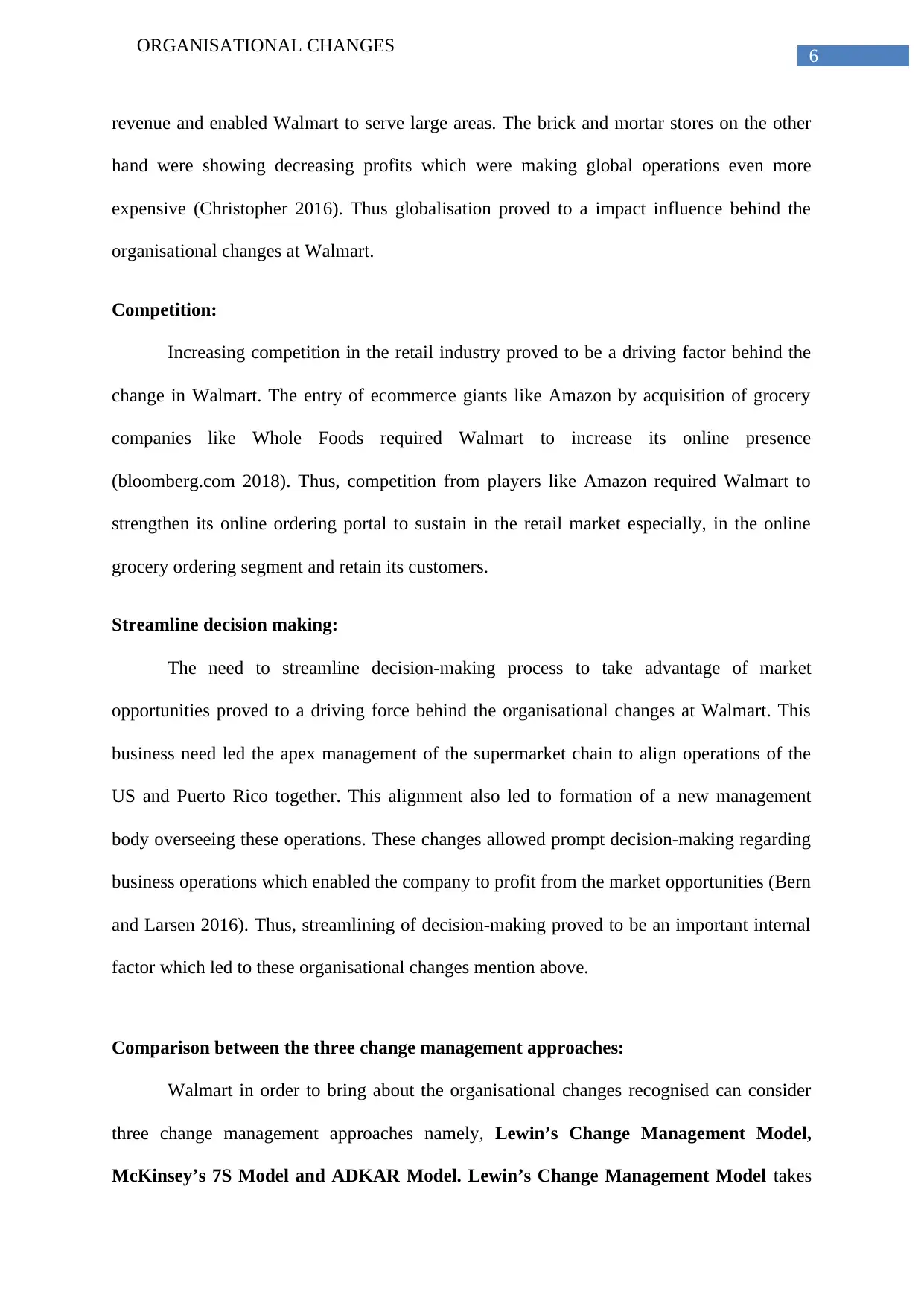
6
ORGANISATIONAL CHANGES
revenue and enabled Walmart to serve large areas. The brick and mortar stores on the other
hand were showing decreasing profits which were making global operations even more
expensive (Christopher 2016). Thus globalisation proved to a impact influence behind the
organisational changes at Walmart.
Competition:
Increasing competition in the retail industry proved to be a driving factor behind the
change in Walmart. The entry of ecommerce giants like Amazon by acquisition of grocery
companies like Whole Foods required Walmart to increase its online presence
(bloomberg.com 2018). Thus, competition from players like Amazon required Walmart to
strengthen its online ordering portal to sustain in the retail market especially, in the online
grocery ordering segment and retain its customers.
Streamline decision making:
The need to streamline decision-making process to take advantage of market
opportunities proved to a driving force behind the organisational changes at Walmart. This
business need led the apex management of the supermarket chain to align operations of the
US and Puerto Rico together. This alignment also led to formation of a new management
body overseeing these operations. These changes allowed prompt decision-making regarding
business operations which enabled the company to profit from the market opportunities (Bern
and Larsen 2016). Thus, streamlining of decision-making proved to be an important internal
factor which led to these organisational changes mention above.
Comparison between the three change management approaches:
Walmart in order to bring about the organisational changes recognised can consider
three change management approaches namely, Lewin’s Change Management Model,
McKinsey’s 7S Model and ADKAR Model. Lewin’s Change Management Model takes
ORGANISATIONAL CHANGES
revenue and enabled Walmart to serve large areas. The brick and mortar stores on the other
hand were showing decreasing profits which were making global operations even more
expensive (Christopher 2016). Thus globalisation proved to a impact influence behind the
organisational changes at Walmart.
Competition:
Increasing competition in the retail industry proved to be a driving factor behind the
change in Walmart. The entry of ecommerce giants like Amazon by acquisition of grocery
companies like Whole Foods required Walmart to increase its online presence
(bloomberg.com 2018). Thus, competition from players like Amazon required Walmart to
strengthen its online ordering portal to sustain in the retail market especially, in the online
grocery ordering segment and retain its customers.
Streamline decision making:
The need to streamline decision-making process to take advantage of market
opportunities proved to a driving force behind the organisational changes at Walmart. This
business need led the apex management of the supermarket chain to align operations of the
US and Puerto Rico together. This alignment also led to formation of a new management
body overseeing these operations. These changes allowed prompt decision-making regarding
business operations which enabled the company to profit from the market opportunities (Bern
and Larsen 2016). Thus, streamlining of decision-making proved to be an important internal
factor which led to these organisational changes mention above.
Comparison between the three change management approaches:
Walmart in order to bring about the organisational changes recognised can consider
three change management approaches namely, Lewin’s Change Management Model,
McKinsey’s 7S Model and ADKAR Model. Lewin’s Change Management Model takes
Paraphrase This Document
Need a fresh take? Get an instant paraphrase of this document with our AI Paraphraser
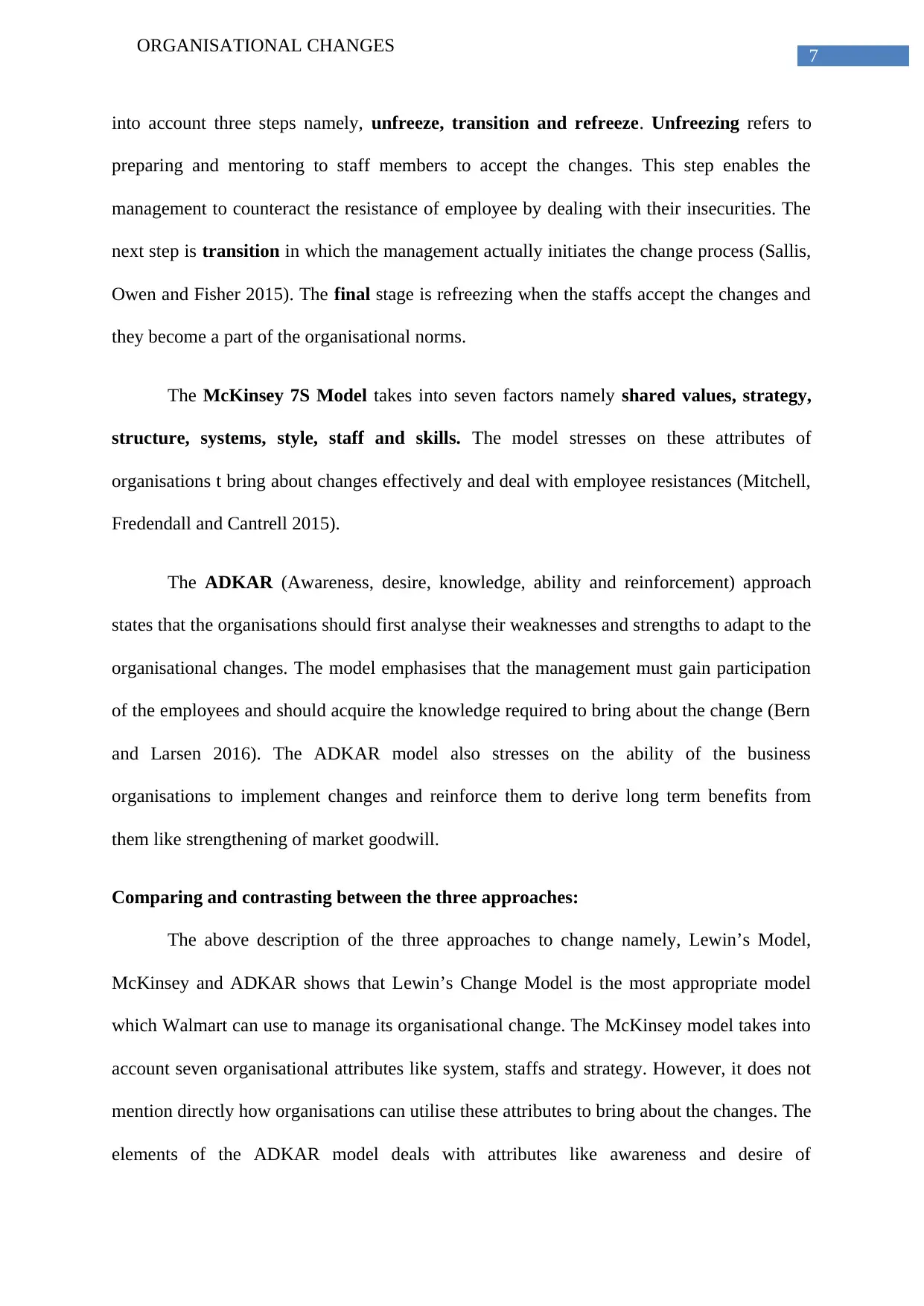
7
ORGANISATIONAL CHANGES
into account three steps namely, unfreeze, transition and refreeze. Unfreezing refers to
preparing and mentoring to staff members to accept the changes. This step enables the
management to counteract the resistance of employee by dealing with their insecurities. The
next step is transition in which the management actually initiates the change process (Sallis,
Owen and Fisher 2015). The final stage is refreezing when the staffs accept the changes and
they become a part of the organisational norms.
The McKinsey 7S Model takes into seven factors namely shared values, strategy,
structure, systems, style, staff and skills. The model stresses on these attributes of
organisations t bring about changes effectively and deal with employee resistances (Mitchell,
Fredendall and Cantrell 2015).
The ADKAR (Awareness, desire, knowledge, ability and reinforcement) approach
states that the organisations should first analyse their weaknesses and strengths to adapt to the
organisational changes. The model emphasises that the management must gain participation
of the employees and should acquire the knowledge required to bring about the change (Bern
and Larsen 2016). The ADKAR model also stresses on the ability of the business
organisations to implement changes and reinforce them to derive long term benefits from
them like strengthening of market goodwill.
Comparing and contrasting between the three approaches:
The above description of the three approaches to change namely, Lewin’s Model,
McKinsey and ADKAR shows that Lewin’s Change Model is the most appropriate model
which Walmart can use to manage its organisational change. The McKinsey model takes into
account seven organisational attributes like system, staffs and strategy. However, it does not
mention directly how organisations can utilise these attributes to bring about the changes. The
elements of the ADKAR model deals with attributes like awareness and desire of
ORGANISATIONAL CHANGES
into account three steps namely, unfreeze, transition and refreeze. Unfreezing refers to
preparing and mentoring to staff members to accept the changes. This step enables the
management to counteract the resistance of employee by dealing with their insecurities. The
next step is transition in which the management actually initiates the change process (Sallis,
Owen and Fisher 2015). The final stage is refreezing when the staffs accept the changes and
they become a part of the organisational norms.
The McKinsey 7S Model takes into seven factors namely shared values, strategy,
structure, systems, style, staff and skills. The model stresses on these attributes of
organisations t bring about changes effectively and deal with employee resistances (Mitchell,
Fredendall and Cantrell 2015).
The ADKAR (Awareness, desire, knowledge, ability and reinforcement) approach
states that the organisations should first analyse their weaknesses and strengths to adapt to the
organisational changes. The model emphasises that the management must gain participation
of the employees and should acquire the knowledge required to bring about the change (Bern
and Larsen 2016). The ADKAR model also stresses on the ability of the business
organisations to implement changes and reinforce them to derive long term benefits from
them like strengthening of market goodwill.
Comparing and contrasting between the three approaches:
The above description of the three approaches to change namely, Lewin’s Model,
McKinsey and ADKAR shows that Lewin’s Change Model is the most appropriate model
which Walmart can use to manage its organisational change. The McKinsey model takes into
account seven organisational attributes like system, staffs and strategy. However, it does not
mention directly how organisations can utilise these attributes to bring about the changes. The
elements of the ADKAR model deals with attributes like awareness and desire of
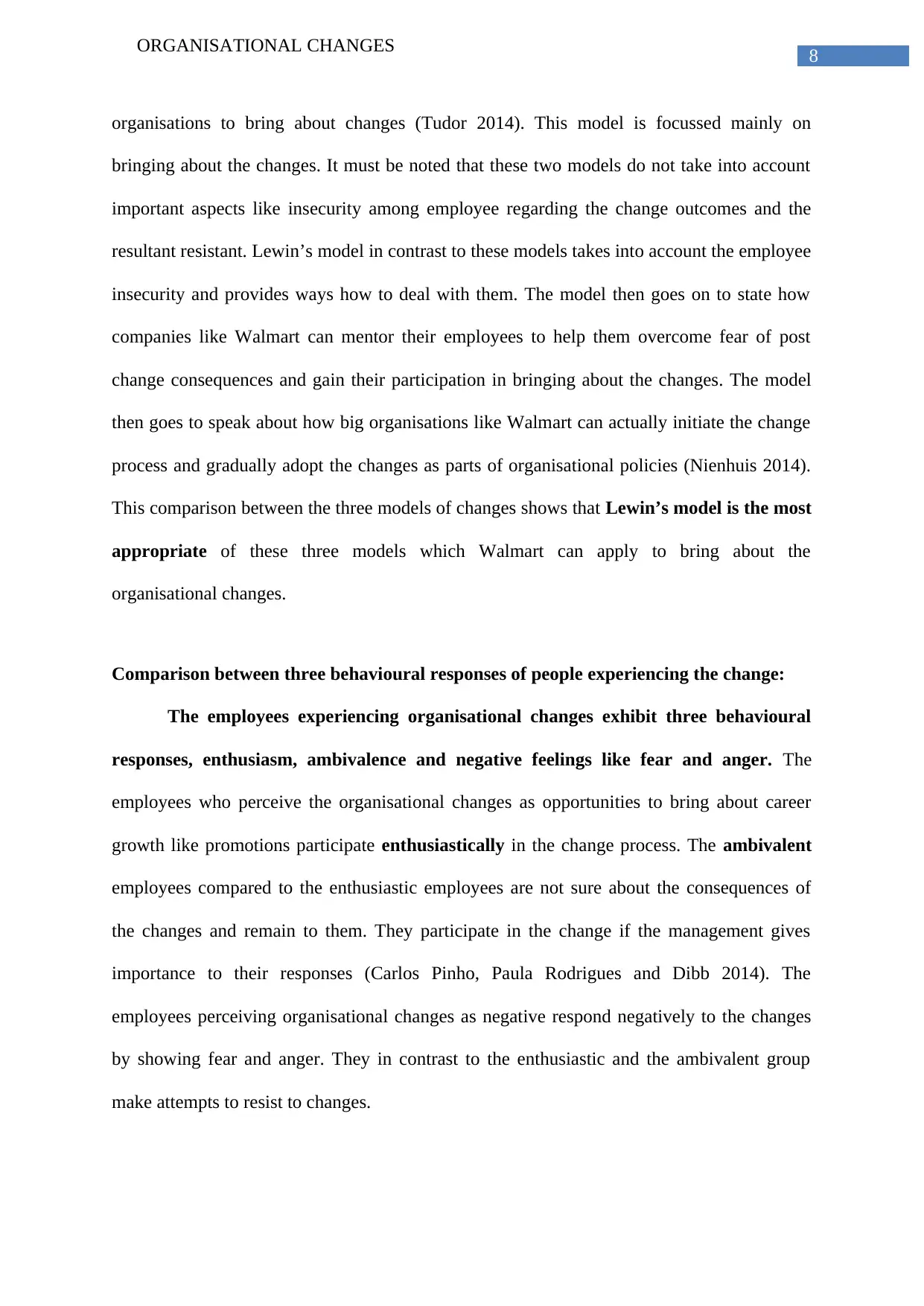
8
ORGANISATIONAL CHANGES
organisations to bring about changes (Tudor 2014). This model is focussed mainly on
bringing about the changes. It must be noted that these two models do not take into account
important aspects like insecurity among employee regarding the change outcomes and the
resultant resistant. Lewin’s model in contrast to these models takes into account the employee
insecurity and provides ways how to deal with them. The model then goes on to state how
companies like Walmart can mentor their employees to help them overcome fear of post
change consequences and gain their participation in bringing about the changes. The model
then goes to speak about how big organisations like Walmart can actually initiate the change
process and gradually adopt the changes as parts of organisational policies (Nienhuis 2014).
This comparison between the three models of changes shows that Lewin’s model is the most
appropriate of these three models which Walmart can apply to bring about the
organisational changes.
Comparison between three behavioural responses of people experiencing the change:
The employees experiencing organisational changes exhibit three behavioural
responses, enthusiasm, ambivalence and negative feelings like fear and anger. The
employees who perceive the organisational changes as opportunities to bring about career
growth like promotions participate enthusiastically in the change process. The ambivalent
employees compared to the enthusiastic employees are not sure about the consequences of
the changes and remain to them. They participate in the change if the management gives
importance to their responses (Carlos Pinho, Paula Rodrigues and Dibb 2014). The
employees perceiving organisational changes as negative respond negatively to the changes
by showing fear and anger. They in contrast to the enthusiastic and the ambivalent group
make attempts to resist to changes.
ORGANISATIONAL CHANGES
organisations to bring about changes (Tudor 2014). This model is focussed mainly on
bringing about the changes. It must be noted that these two models do not take into account
important aspects like insecurity among employee regarding the change outcomes and the
resultant resistant. Lewin’s model in contrast to these models takes into account the employee
insecurity and provides ways how to deal with them. The model then goes on to state how
companies like Walmart can mentor their employees to help them overcome fear of post
change consequences and gain their participation in bringing about the changes. The model
then goes to speak about how big organisations like Walmart can actually initiate the change
process and gradually adopt the changes as parts of organisational policies (Nienhuis 2014).
This comparison between the three models of changes shows that Lewin’s model is the most
appropriate of these three models which Walmart can apply to bring about the
organisational changes.
Comparison between three behavioural responses of people experiencing the change:
The employees experiencing organisational changes exhibit three behavioural
responses, enthusiasm, ambivalence and negative feelings like fear and anger. The
employees who perceive the organisational changes as opportunities to bring about career
growth like promotions participate enthusiastically in the change process. The ambivalent
employees compared to the enthusiastic employees are not sure about the consequences of
the changes and remain to them. They participate in the change if the management gives
importance to their responses (Carlos Pinho, Paula Rodrigues and Dibb 2014). The
employees perceiving organisational changes as negative respond negatively to the changes
by showing fear and anger. They in contrast to the enthusiastic and the ambivalent group
make attempts to resist to changes.
⊘ This is a preview!⊘
Do you want full access?
Subscribe today to unlock all pages.

Trusted by 1+ million students worldwide
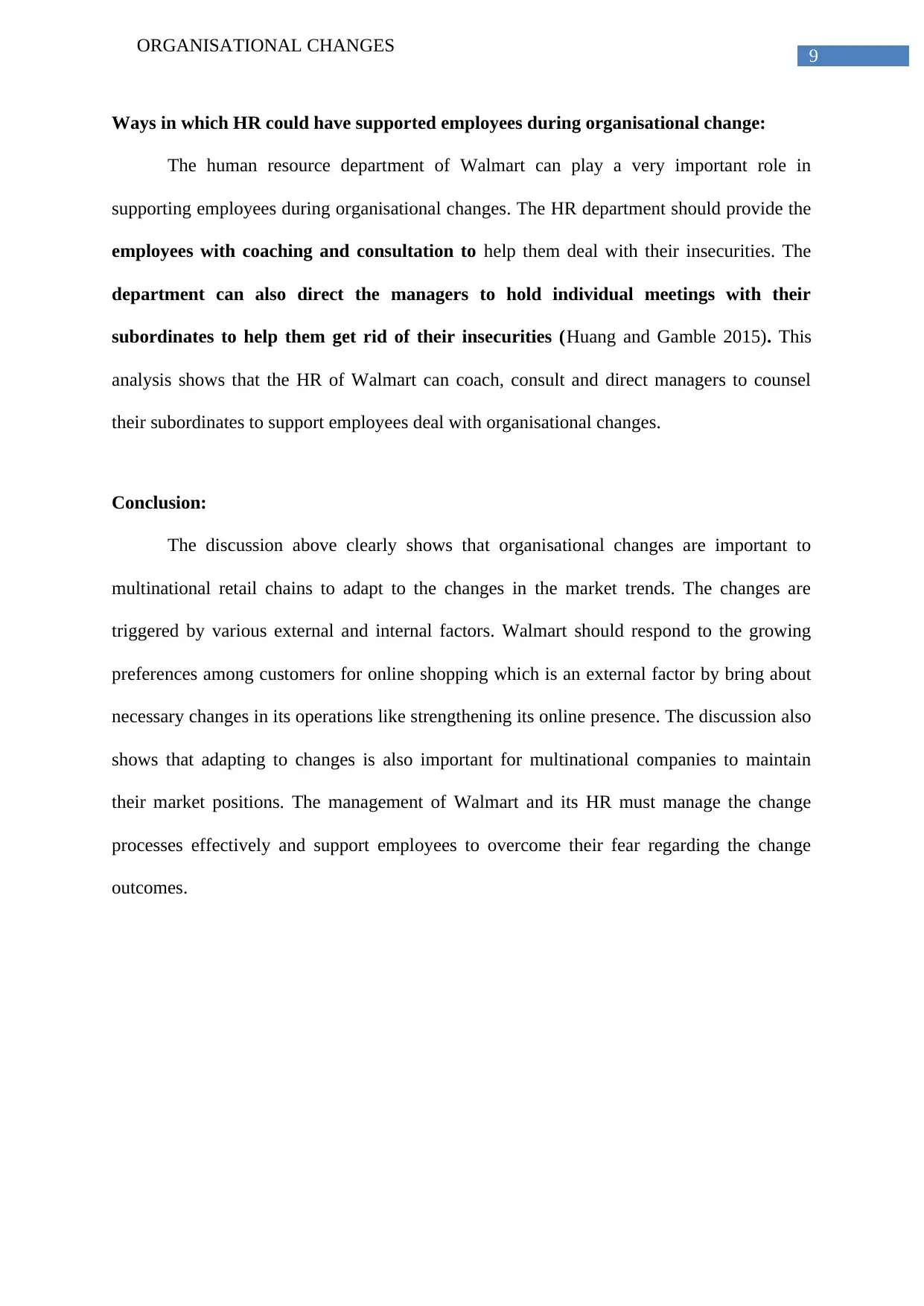
9
ORGANISATIONAL CHANGES
Ways in which HR could have supported employees during organisational change:
The human resource department of Walmart can play a very important role in
supporting employees during organisational changes. The HR department should provide the
employees with coaching and consultation to help them deal with their insecurities. The
department can also direct the managers to hold individual meetings with their
subordinates to help them get rid of their insecurities (Huang and Gamble 2015). This
analysis shows that the HR of Walmart can coach, consult and direct managers to counsel
their subordinates to support employees deal with organisational changes.
Conclusion:
The discussion above clearly shows that organisational changes are important to
multinational retail chains to adapt to the changes in the market trends. The changes are
triggered by various external and internal factors. Walmart should respond to the growing
preferences among customers for online shopping which is an external factor by bring about
necessary changes in its operations like strengthening its online presence. The discussion also
shows that adapting to changes is also important for multinational companies to maintain
their market positions. The management of Walmart and its HR must manage the change
processes effectively and support employees to overcome their fear regarding the change
outcomes.
ORGANISATIONAL CHANGES
Ways in which HR could have supported employees during organisational change:
The human resource department of Walmart can play a very important role in
supporting employees during organisational changes. The HR department should provide the
employees with coaching and consultation to help them deal with their insecurities. The
department can also direct the managers to hold individual meetings with their
subordinates to help them get rid of their insecurities (Huang and Gamble 2015). This
analysis shows that the HR of Walmart can coach, consult and direct managers to counsel
their subordinates to support employees deal with organisational changes.
Conclusion:
The discussion above clearly shows that organisational changes are important to
multinational retail chains to adapt to the changes in the market trends. The changes are
triggered by various external and internal factors. Walmart should respond to the growing
preferences among customers for online shopping which is an external factor by bring about
necessary changes in its operations like strengthening its online presence. The discussion also
shows that adapting to changes is also important for multinational companies to maintain
their market positions. The management of Walmart and its HR must manage the change
processes effectively and support employees to overcome their fear regarding the change
outcomes.
Paraphrase This Document
Need a fresh take? Get an instant paraphrase of this document with our AI Paraphraser
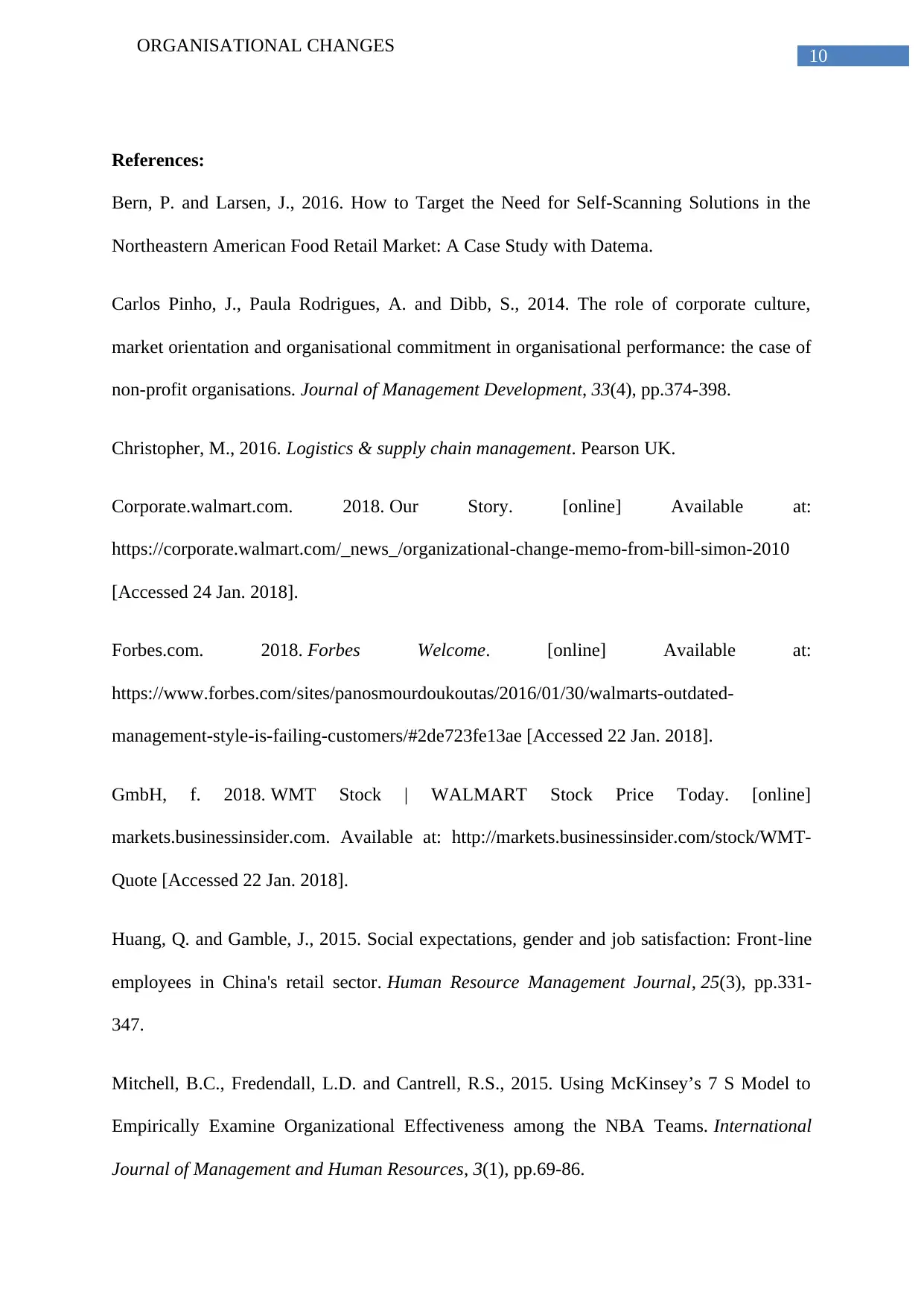
10
ORGANISATIONAL CHANGES
References:
Bern, P. and Larsen, J., 2016. How to Target the Need for Self-Scanning Solutions in the
Northeastern American Food Retail Market: A Case Study with Datema.
Carlos Pinho, J., Paula Rodrigues, A. and Dibb, S., 2014. The role of corporate culture,
market orientation and organisational commitment in organisational performance: the case of
non-profit organisations. Journal of Management Development, 33(4), pp.374-398.
Christopher, M., 2016. Logistics & supply chain management. Pearson UK.
Corporate.walmart.com. 2018. Our Story. [online] Available at:
https://corporate.walmart.com/_news_/organizational-change-memo-from-bill-simon-2010
[Accessed 24 Jan. 2018].
Forbes.com. 2018. Forbes Welcome. [online] Available at:
https://www.forbes.com/sites/panosmourdoukoutas/2016/01/30/walmarts-outdated-
management-style-is-failing-customers/#2de723fe13ae [Accessed 22 Jan. 2018].
GmbH, f. 2018. WMT Stock | WALMART Stock Price Today. [online]
markets.businessinsider.com. Available at: http://markets.businessinsider.com/stock/WMT-
Quote [Accessed 22 Jan. 2018].
Huang, Q. and Gamble, J., 2015. Social expectations, gender and job satisfaction: Front‐line
employees in China's retail sector. Human Resource Management Journal, 25(3), pp.331-
347.
Mitchell, B.C., Fredendall, L.D. and Cantrell, R.S., 2015. Using McKinsey’s 7 S Model to
Empirically Examine Organizational Effectiveness among the NBA Teams. International
Journal of Management and Human Resources, 3(1), pp.69-86.
ORGANISATIONAL CHANGES
References:
Bern, P. and Larsen, J., 2016. How to Target the Need for Self-Scanning Solutions in the
Northeastern American Food Retail Market: A Case Study with Datema.
Carlos Pinho, J., Paula Rodrigues, A. and Dibb, S., 2014. The role of corporate culture,
market orientation and organisational commitment in organisational performance: the case of
non-profit organisations. Journal of Management Development, 33(4), pp.374-398.
Christopher, M., 2016. Logistics & supply chain management. Pearson UK.
Corporate.walmart.com. 2018. Our Story. [online] Available at:
https://corporate.walmart.com/_news_/organizational-change-memo-from-bill-simon-2010
[Accessed 24 Jan. 2018].
Forbes.com. 2018. Forbes Welcome. [online] Available at:
https://www.forbes.com/sites/panosmourdoukoutas/2016/01/30/walmarts-outdated-
management-style-is-failing-customers/#2de723fe13ae [Accessed 22 Jan. 2018].
GmbH, f. 2018. WMT Stock | WALMART Stock Price Today. [online]
markets.businessinsider.com. Available at: http://markets.businessinsider.com/stock/WMT-
Quote [Accessed 22 Jan. 2018].
Huang, Q. and Gamble, J., 2015. Social expectations, gender and job satisfaction: Front‐line
employees in China's retail sector. Human Resource Management Journal, 25(3), pp.331-
347.
Mitchell, B.C., Fredendall, L.D. and Cantrell, R.S., 2015. Using McKinsey’s 7 S Model to
Empirically Examine Organizational Effectiveness among the NBA Teams. International
Journal of Management and Human Resources, 3(1), pp.69-86.
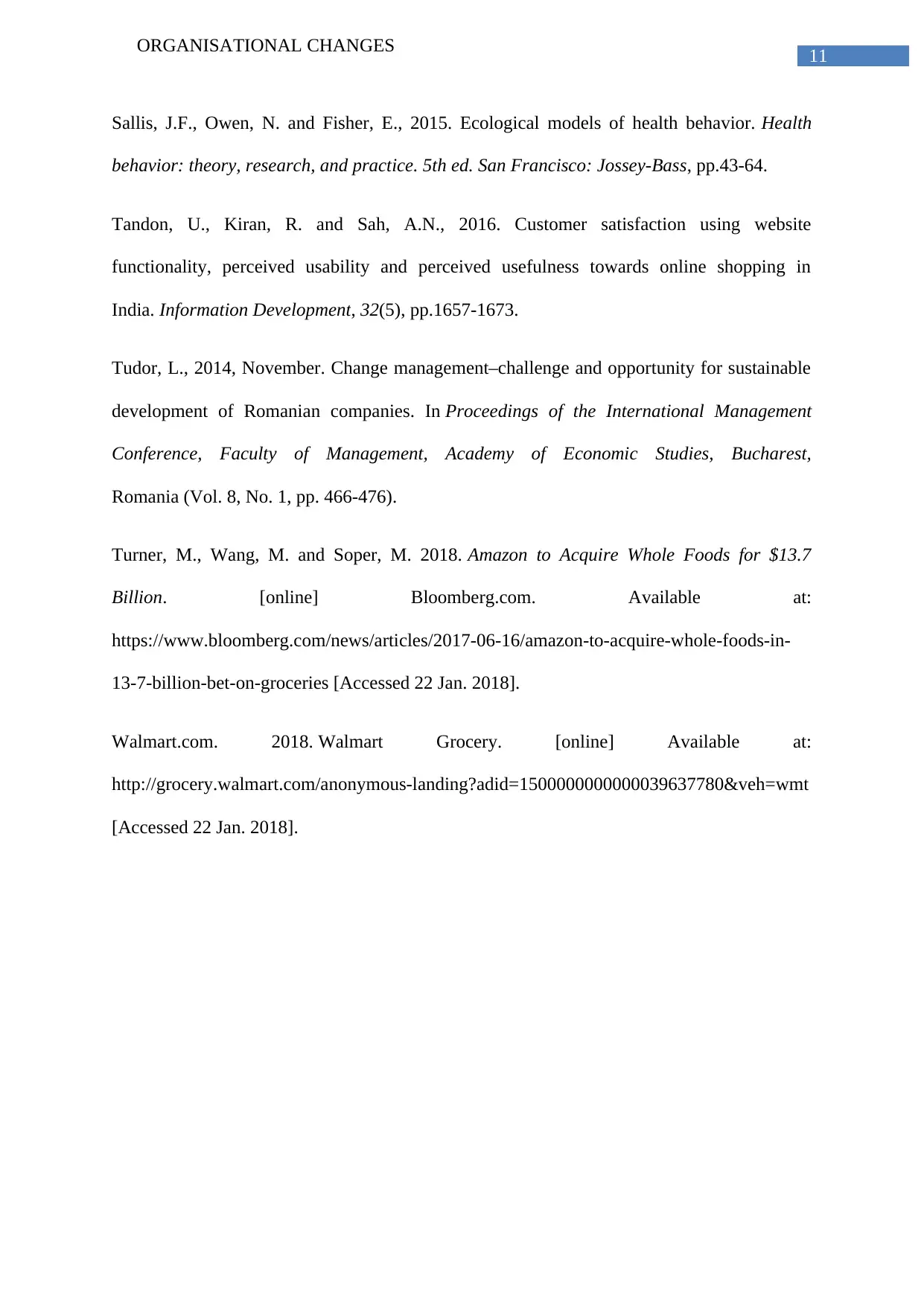
11
ORGANISATIONAL CHANGES
Sallis, J.F., Owen, N. and Fisher, E., 2015. Ecological models of health behavior. Health
behavior: theory, research, and practice. 5th ed. San Francisco: Jossey-Bass, pp.43-64.
Tandon, U., Kiran, R. and Sah, A.N., 2016. Customer satisfaction using website
functionality, perceived usability and perceived usefulness towards online shopping in
India. Information Development, 32(5), pp.1657-1673.
Tudor, L., 2014, November. Change management–challenge and opportunity for sustainable
development of Romanian companies. In Proceedings of the International Management
Conference, Faculty of Management, Academy of Economic Studies, Bucharest,
Romania (Vol. 8, No. 1, pp. 466-476).
Turner, M., Wang, M. and Soper, M. 2018. Amazon to Acquire Whole Foods for $13.7
Billion. [online] Bloomberg.com. Available at:
https://www.bloomberg.com/news/articles/2017-06-16/amazon-to-acquire-whole-foods-in-
13-7-billion-bet-on-groceries [Accessed 22 Jan. 2018].
Walmart.com. 2018. Walmart Grocery. [online] Available at:
http://grocery.walmart.com/anonymous-landing?adid=1500000000000039637780&veh=wmt
[Accessed 22 Jan. 2018].
ORGANISATIONAL CHANGES
Sallis, J.F., Owen, N. and Fisher, E., 2015. Ecological models of health behavior. Health
behavior: theory, research, and practice. 5th ed. San Francisco: Jossey-Bass, pp.43-64.
Tandon, U., Kiran, R. and Sah, A.N., 2016. Customer satisfaction using website
functionality, perceived usability and perceived usefulness towards online shopping in
India. Information Development, 32(5), pp.1657-1673.
Tudor, L., 2014, November. Change management–challenge and opportunity for sustainable
development of Romanian companies. In Proceedings of the International Management
Conference, Faculty of Management, Academy of Economic Studies, Bucharest,
Romania (Vol. 8, No. 1, pp. 466-476).
Turner, M., Wang, M. and Soper, M. 2018. Amazon to Acquire Whole Foods for $13.7
Billion. [online] Bloomberg.com. Available at:
https://www.bloomberg.com/news/articles/2017-06-16/amazon-to-acquire-whole-foods-in-
13-7-billion-bet-on-groceries [Accessed 22 Jan. 2018].
Walmart.com. 2018. Walmart Grocery. [online] Available at:
http://grocery.walmart.com/anonymous-landing?adid=1500000000000039637780&veh=wmt
[Accessed 22 Jan. 2018].
⊘ This is a preview!⊘
Do you want full access?
Subscribe today to unlock all pages.

Trusted by 1+ million students worldwide
1 out of 12
Related Documents
Your All-in-One AI-Powered Toolkit for Academic Success.
+13062052269
info@desklib.com
Available 24*7 on WhatsApp / Email
![[object Object]](/_next/static/media/star-bottom.7253800d.svg)
Unlock your academic potential
Copyright © 2020–2025 A2Z Services. All Rights Reserved. Developed and managed by ZUCOL.





